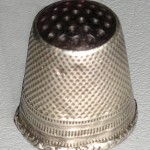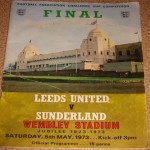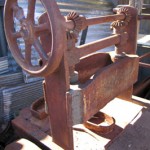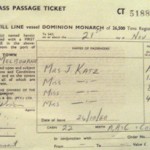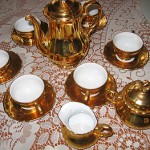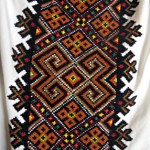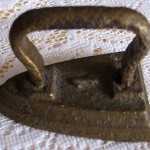(nee Schuhmann)
German
Berlin, Germany
Genoa, Italy on 4 September 1950
Melbourne on 29 September 1950
Bonegilla for 6 weeks
We rented one bedroom in a house in Walla Walla, near Albury.
Cleaning and cooking for the Bandiana Post Office residence.
Author
I was born in Berlin on 22 March 1924 and when I was four weeks old my parents moved to Erksnitz. My father took up the position of Mayor of Saxony (Sachsen), a town of 20,000 people. It is not the same as in Australia; you are not elected by the public but appointed to the position. We stayed there for ten years and my father was Mayor for five years.
I had a lovely childhood; my parents made it so exciting for us as children. My mother used to show little films of fairy tales – no sound of course, she added the sound.
I started school when I was six. It was the custom that each child had a large ice-cream cone shaped container that was filled with lollies. Some of the children’s families were too poor to afford the lollies so they would fill the bottom of the container with potatoes. But if the container burst, all the potatoes went everywhere and the children and their families were so embarrassed.
When I was ten, I received a thimble from my godmother Dora, she was my mother’s closest friend and they worked together as nurses in field hospitals in the First World War. My mother used to make me embroider doilies for my godmother, aunts and grandmother every year. They must have been so sick of doilies!
Soon after we moved to Bavaria and it was a totally different schooling system. In Saxony we learnt English, but when we moved to Bavaria they used French, so my father taught me. His French was faultless and he simply made me do everything in French. I soon caught up with the other pupils.
In 1938 Hitler closed all the private schools in Germany. I had been sent to a convent school, but when this school close[d], I was sent to a co-education public school. I was 14 years old and the boys used to tease me terribly. At this stage I didn’t like boys very much, but I caught up later.
Shortly after I moved to a training college that was specifically designed to teach childcare and pre-school. I studied what they now call early childhood education. That was wonderful. I was able to finish my studies even though the [Second World] war had started.
After I had finished my studies I worked in different kindergartens throughout Bavaria. Many of the children I taught were evacuees. Hunger was our worst enemy. The food rationing during the war was terrible. We were allocated 125 grams of butter and 150 grams of meat per week! It was never enough.
My brother was drafted to the German army at the age of seventeen after he made an anti-Nazi comment in the local picture theatre and was overheard. My parents had always been anti-Nazi and that made it very hard for us children. My brother was in a regiment with all sorts of undesirable people who weren’t politically to be trusted. [He] was very badly wounded near the frontline and was soon after transferred. It was very difficult towards the end of the war; we couldn’t send or receive letters and didn’t know where my brother was or if he was dead or alive.
My mother and I were still living in Starnberg, Bavaria. We were based in the American quarter and as soon as the war ended I started working [for] the American Red Cross. I assisted to help entertain the American troops when they were not working. We played cards, sport, even ‘ping pong’. It also provided one main meal a day when food was still very scarce.
I met my future husband George at work. By then I was working for the military government as a telephonist. They gave me a letter to take to the field police, I walked into that office and there was George – and he never let me go again. When we decided to get married, my mother and I did not eat meat for eight weeks so we could feed the ten guests at our wedding. We lived with my mother after we were first married in a small apartment in Starnberg. Our first child, Harriet, was born on 28 January 1948.
Both George and I wanted to immigrate because we felt the Russians were too close, we didn’t feel safe in Germany. We wanted to immigrate to America, we had our names down, but it was taking forever. So George came home one day and said [he's] put our names down to immigrate to Australia. “Where’s that?” I asked. My father had an old book on Australia so I looked at that and read about the Aborigines and the sheep farming.
Had we known how little welcome we were at first, we would not have come. No. People called us all sorts of names and laughed at our clothes because they were different.
We started our journey by going to Displaced Persons’ camps; we were in three in total, two in Germany and one in Italy. The men were in a different barracks in the [German] camps; in Italy we were able to live together.
It was pretty horrid. Some of the people did not wash. The children were allowed to bath once a week in a copper tub, they used to put a little disinfectant in the water to stop germs. They gave the children measles and meningitis vaccinations, but they were either too strong or too weak. Four children died at camp while we were there.
Harriet became very ill from measles [and] was in hospital for weeks so we stayed at the camp, waiting for her to improve. I don’t even like to think about it. I was not allowed to stay with Harriet. I could only see her through a crack in the door and she was very distressed.
Harriet improved and we departed by ship aboard the Castel Bianco on 4 September 1950. There were about 1,000 people who travelled across and about 300-400 women and children squeezed into one room; we were separated from the men. The food was good; great pasta and lovely coffee. There was no real entertainment, except one lady played a zitter – a bit like a harp – for the officers, not for us.
We arrived into Melbourne on 29 September 1950 and travelled by train to Bonegilla. It was getting dark and a bus took us to Bonegilla from Albury train station. We had to go through more checks and the matron at the hospital took Harriet out of my arms. “That girl’s got whooping cough”, she said.
Harriet became very ill initially from whooping cough and then we discovered she had tuberculosis. Harriet was in Bonegilla Hospital for many months. I was only allowed to visit her once a week on Sunday for 30 minutes. I used to crawl on my tummy through the grass to catch sight of Harriet; she was out on the veranda, you see. It was just inhuman to do that to a mother and there were quite a few of us.
George was sent to Sydney to work for the metropolitan water board. I couldn’t understand it; you bring people across the world to another country and then break them apart. I worked as a cleaner and cook at the Bandiana Post Office house. I stayed there for one month before we left Bonegilla and George returned from Sydney.
Harriet was released from hospital the day we moved to Walla Walla, a small township outside Albury. We rented a small room and finally we were all together as a family. George first worked at the place where we were living, but soon gained work assisting to build St. Paul’s College, Walla Walla. George really enjoyed this and learnt skills in carpentry.
We brought our first block of land in Walla Walla for £40. We had neither water nor electricity but George built our first home with assistance from a friend. It was a two bedroom fibro house with no ceilings. We had to bucket water from the pastor’s house and we used a primus with kerosene for cooking and light.
We set up our first home with our few meagre possessions. One special belonging was my family sugar cube holder. [It] is from my grandmother, on my father’s side. It is something I inherited when my mother passed away.
When we moved to Walla, I often experienced prejudice because of my cultural background. However, there was an old lady, Mrs Krause, who taught me smocking and I made a couple of dresses for Harriet. It didn’t matter when I came or when I went, she was so good to me. She was the dearest lady. She was the shining example of Christian kindness, being my friend.
We had our second child, Christine, in 1952, two years after we had migrated. I had Christine in the Culcairn Hospital and I still remember they only had outside toilets!
After four years in Walla, we bought a block of land in North Albury and hired a large semi-trailer truck to move our little fibro home onto our new block. We had to slightly alter our house to fit the Albury City Council regulations and were soon connected to the mains water and electricity.
George became a clerk and went to night school and studied accountancy, he even became a fellow of accountancy. Unfortunately, my qualifications as a kindergarten teacher were not recognised here. Eventually they were, but by then I was very old.
I have twice been an author, of Are you really going to Australia? and Fair Dinkum: A sentimental journey.
I feel people who immigrate now have marvellous opportunities. There is not that prejudice there anymore, we have so many people of different cultures; what George and I experienced would not happen now.


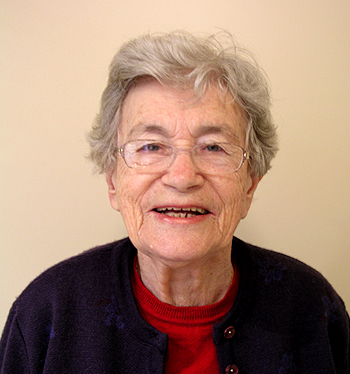


!["[At] Walla, Mrs Krause taught me smocking and I made a couple of dresses for Harriet. It didn’t matter when I came or when I went, she was so good to me. She was the shining example of Christian kindness, being my friend."](../../../cms/wp-content/uploads/2008/10/dress-150x150.jpg)
!["[When] we set up our first home [in Australia], one special belonging was my family sugar cube holder. [It] is from my grandmother, on my father's side."](../../../cms/wp-content/uploads/2008/10/sugar-150x150.jpg)
